Overview
Organizations
- HOME
- >
- Recent events
007
Behavior Signal Processing Laboratory researches intelligent information processing technology that harmonizes humans and machines.
In our laboratory, we are studying intelligent behavioral signal processing technology for human-environment interaction in the real world, based on machine learning and statistical signal processing. In particular, we tackle problems in automatic driving, human behavior understanding, speech conversion, and human-computer interaction technology required for them. For example, recently, we developed a method to evaluate soccer players who create scoring opportunities for teammates by comparing the reference movements generated by trajectory prediction with actual movements.
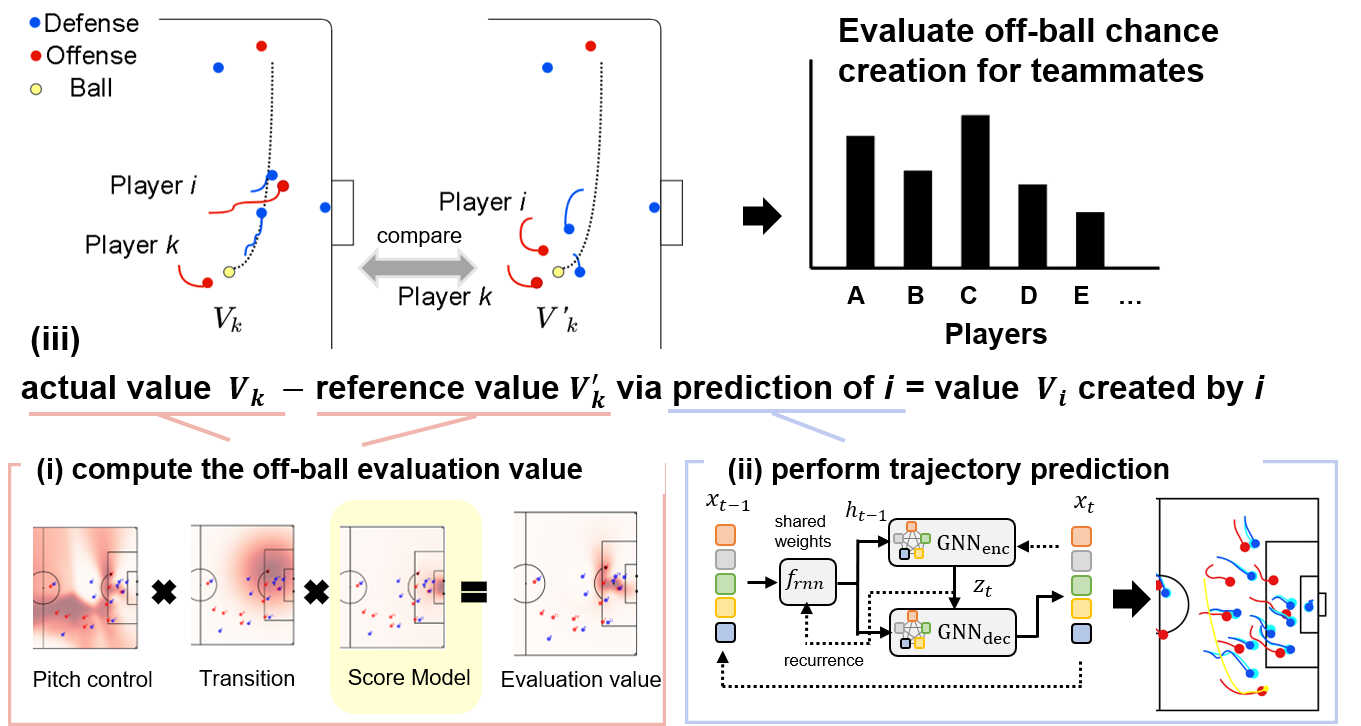
Figure: Overview of our method. (i) First, we compute the off-ball evaluation value. (ii) We then predict players’ trajectories. (iii) Finally, we evaluate movements for teammates by the difference between the evaluation value in the actual game situation and the referenced or predicted game situation.
006
Computer simulations of space plasma processes are performed on supercomputer systems
Space Information Engineering group studies new numerical methods for solving conservation laws in space plasma. Massively-parallel simulation codes are developed based on high-performance computing (HPC) techniques. The computational speed of 1 peta-flops is achieved on the “Flow” supercomputer system Type I at Nagoya University.
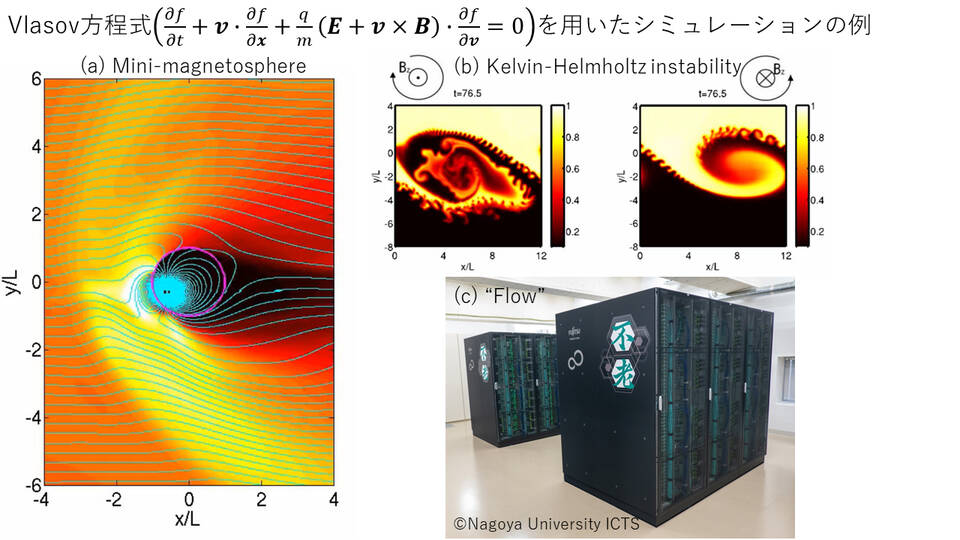
(a) Mini-magnetosphere reproduced with supercomputer “K.” (b) Effect of magnetic field on the development of Kelvin-Helmholtz vortices. (c) Supercomputer “Flow” at Nagoya University.
005
International high-frequency radar network for observing geospace disturbances have been in operation
The Space Observation group has been operating high-radars in Hokkaido, in collaboration with other high-frequency radars operated by more than 10 countries, to monitor electromagnetic disturbances in the ionosphere (90 – 1000 km above the earth) since 2006. This project is referred to as SuperDARN (Super Dual Auroral Radar Network). A lot of scientific results have been obtained from this project.
Details are here
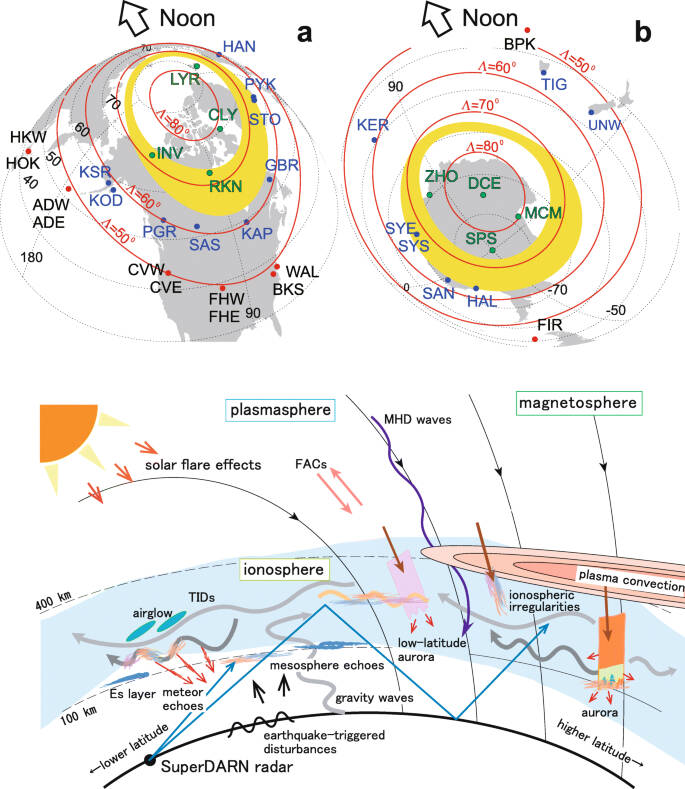
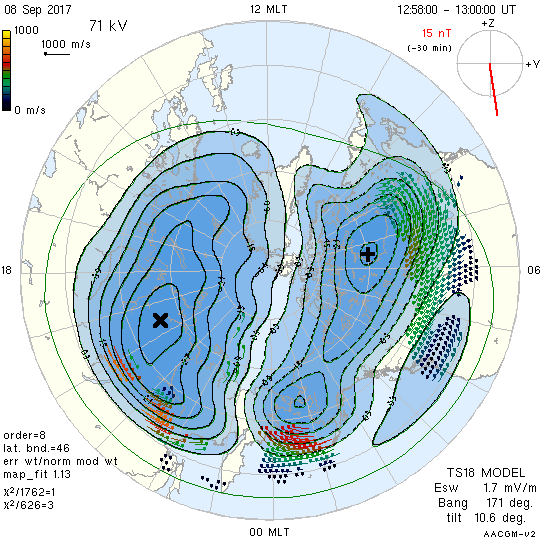
(Top) Schematic plots showing the Northern and Southern Hemisphere SuperDARN radar locations with respect to the auroral oval. A typical auroral oval (yellow) is plotted with the SuperDARN radar locations identified in closed circles (Nishitani et al., 2019). (Middle) Schematic illustration of natural phenomena which can be studied by SuperDARN radars (Nishitani et al., 2019). (Bottom) One example of ionospheric plasma flow pattern obtained by the SuperDARN data. The review paper on the accomplishments of the mid-latitude SuperDARN by Nishitani et al., published in PEPS journal in 2019, received a 2021 PEPS most cited paper award.
004
A real-time spectroscopic system using a fast wavelength switchable terahertz wave parametric generator was newly developed by Kawase laboratory, Department of Electronics.
There is still no practical real-time spectroscopic system using the terahertz wave which is an electromagnetic wave located between radio waves and infrared light. In order to solve this problem, Kawase laboratory has developed a new method to switch the wavelength of an injection seeded terahertz-wave parametric generator (is-TPG) at high speed, and has realized real-time terahertz spectroscopy using up to 17 wavelengths. This achievement has received an award for the best paper presentation at the annual meeting of the Laser Society of Japan and two other workshops.
Details are here
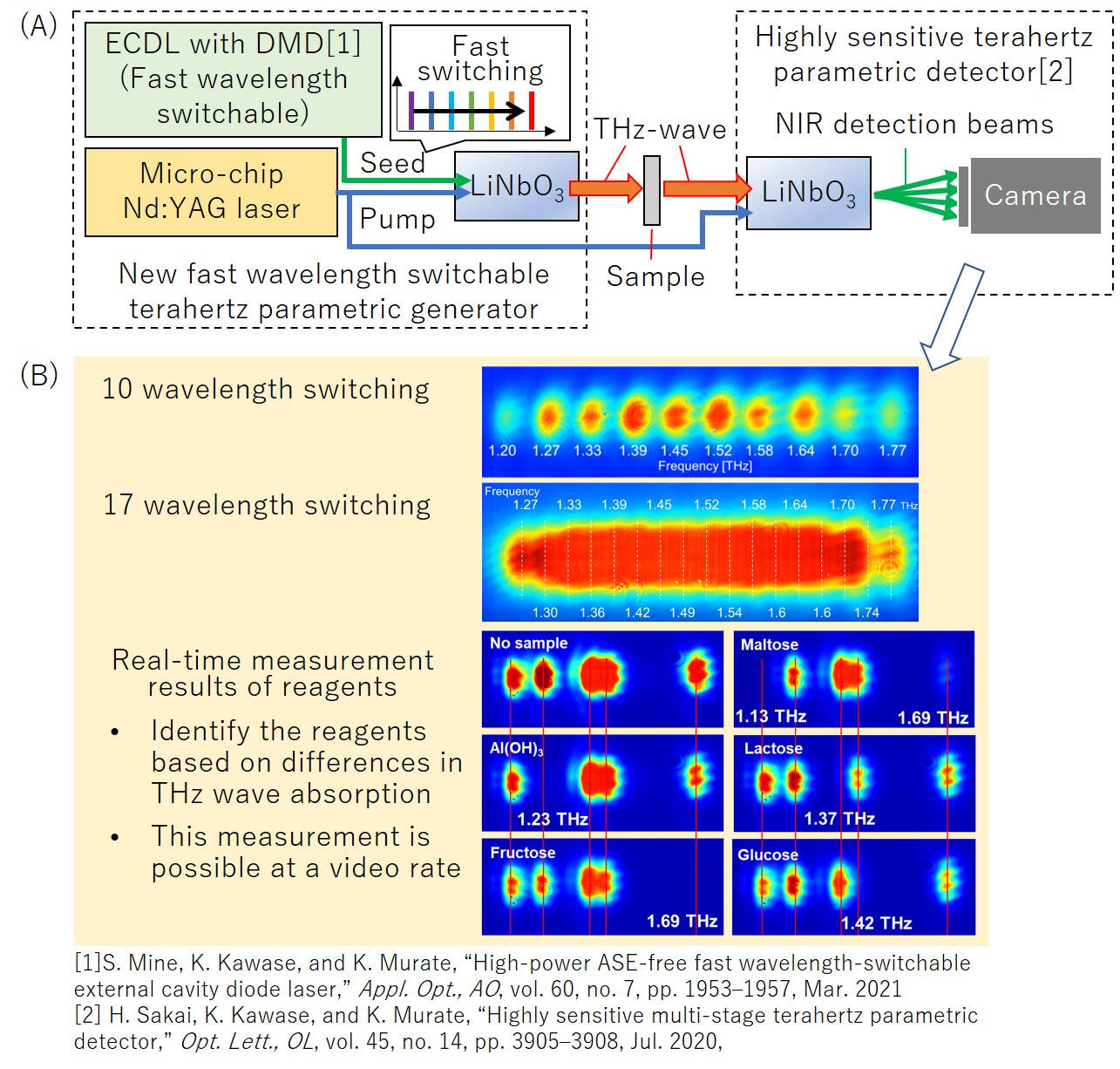
(A) Real-time terahertz-wave spectroscopic system with fast wavelength switching (B) Results of fast wavelength switching up to 17 wavelengths and reagents identification
003
Molecular Dynamics Simulation on Chiral Nano-Needle Fabrication by Opitcal Vortex in Nakamura Lab. (Dept. Electrical Engineering)
Optical vortix is an electromagnetic wave with spiral wavefronts and donut-shaped intensity distributions. Moreover it is expected to be used in new communication modes, material manipulation, and even laser processing. It was reported that the chiral nano-needle structures is fabricated in tantalum by optical vortex laser irradiation. Nakamura Lab. (Dept. Electrical Engineering) has successfully reproduced this chiral nano-needle structure on a computer by modeling the force exerted by the optical vortex on tantalum atoms and calculating the motion of each atom by molecular dynamics simulation. This research was awarded by the Japan Society for Siumlation Technology as the Research Award for 2020.
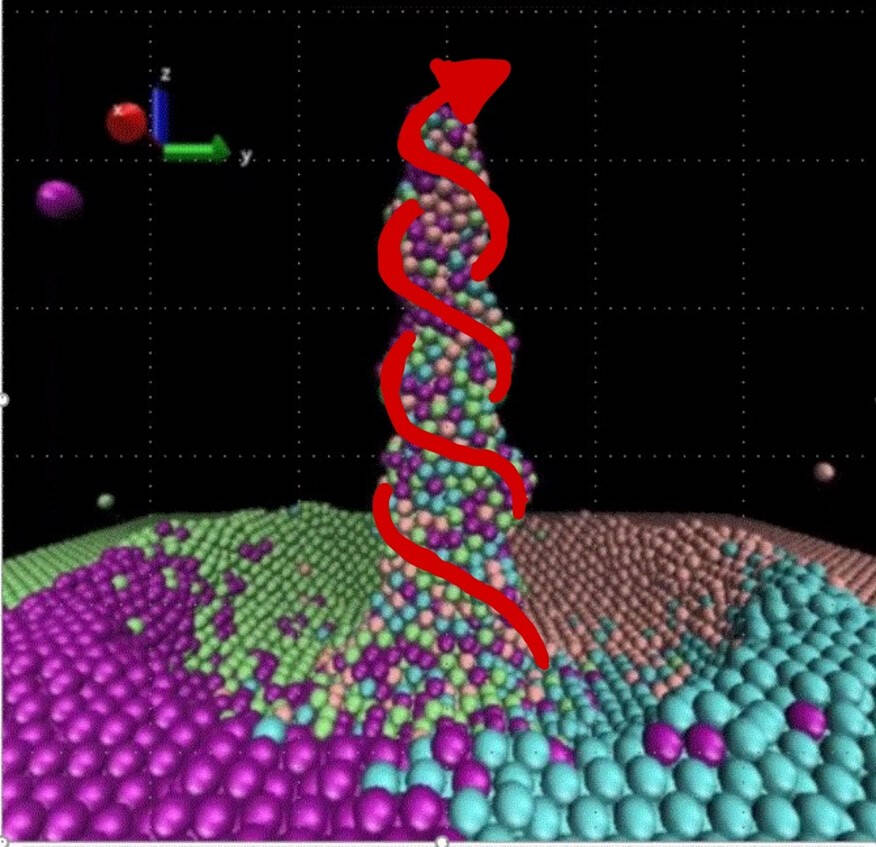
Molecular Dynamics Simulation on Chiral Nano-Needle Fabrication. The red curve denotes the edge of the nanoneedle.
002
Sato & Ogawa Laboratory has been developing a text simplification support system.
Sato & Ogawa Laboratory of Department of Information and Communication Engineering has been developing a support system for simplifying Japanese sentences. This system is designed to generate simplified candidates for difficult expressions, implementing four major modules: (1) sentence splitting, (2) simplification of sentence-ending expressions, (3) lexical simplification, and (4) simplified explanation generation of technical terms. For the simplification of sentence-ending expressions, we proposed and implemented a method that combines our language processing tools Panzer/HaoriBricks3 and the neural-based masked language model BERT, and demonstrated that our method outperformed conventional methods by a wide margin.
Details are here
Details are here
Details are here

Text simplification support system
001
Pi-phase shift was demonstrated in a nitride-based magnetic Josephson junction by Fujimaki laboratory, Department of Electronics.
In the operation of the superconducting flux quantum bit (qubit), which is an elementary device of the quantum computers, the external magnetic flux bias was required to tune the superconducting phase. This requirement is one of the main issues of the flux qubits toward their large-scale integration. By the developed pi-phase-shift nitride-based magnetic Josephson junction, the flux-bias-free operation of the flux qubits can be achieved leading to the realization of the large-scale quantum circuits. This is a collaborative work with National Institute of Information and Communications Technology (NICT), Japan.
Details are here
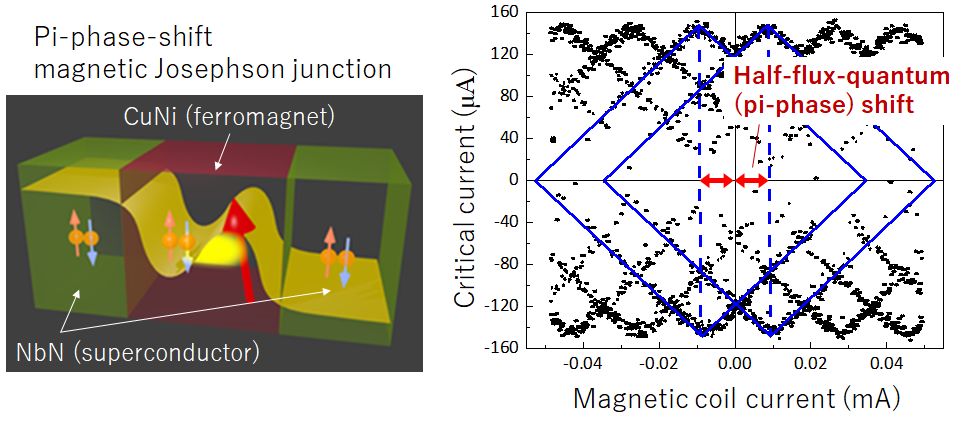
(Left) Schematics of the pi-phase-shift magnetic Josephson junction and (right) the experimental result to show the pi-phase shift.


